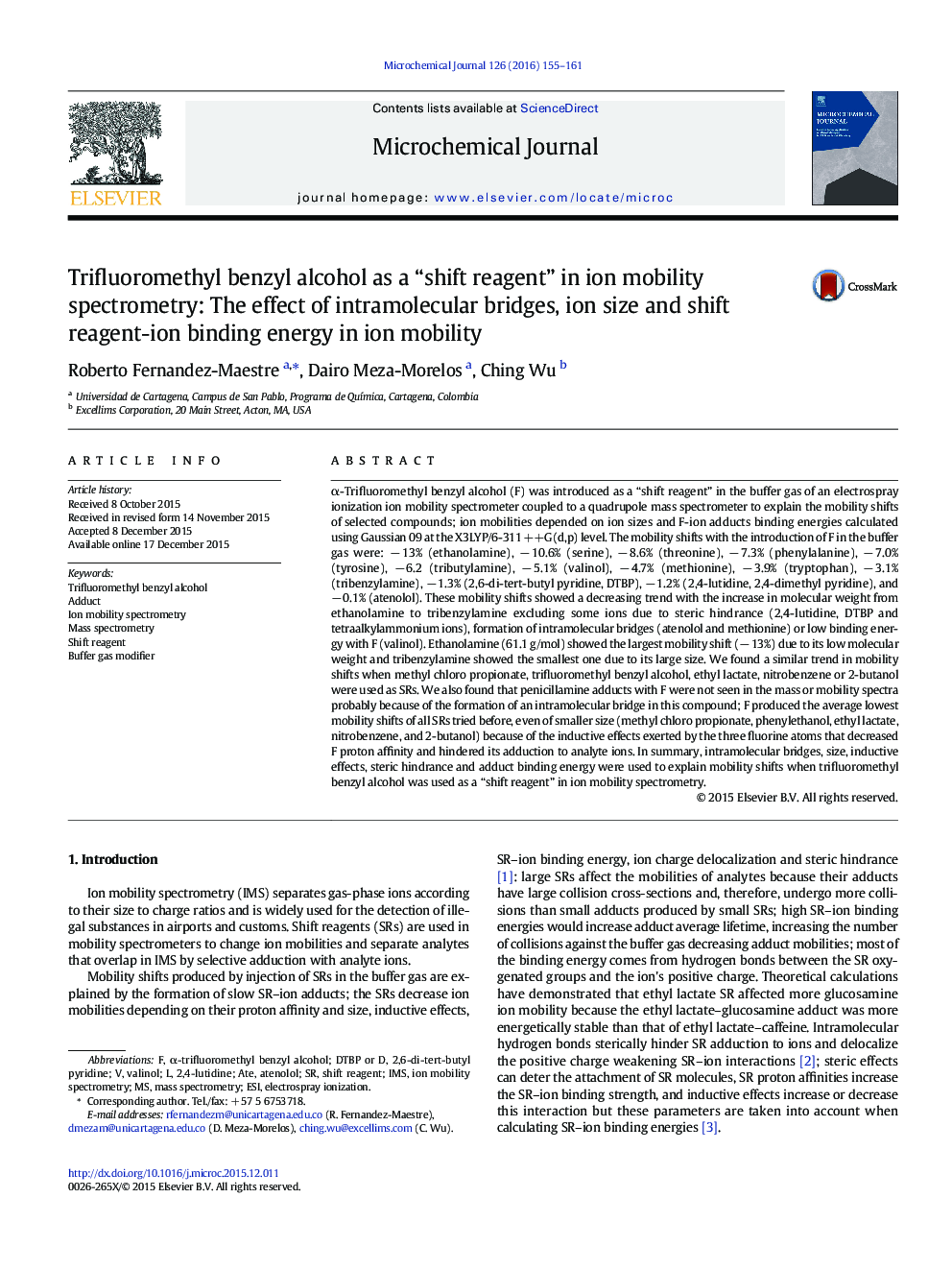| کد مقاله | کد نشریه | سال انتشار | مقاله انگلیسی | نسخه تمام متن |
|---|---|---|---|---|
| 7641458 | 1494868 | 2016 | 7 صفحه PDF | دانلود رایگان |
عنوان انگلیسی مقاله ISI
Trifluoromethyl benzyl alcohol as a “shift reagent” in ion mobility spectrometry: The effect of intramolecular bridges, ion size and shift reagent-ion binding energy in ion mobility
دانلود مقاله + سفارش ترجمه
دانلود مقاله ISI انگلیسی
رایگان برای ایرانیان
کلمات کلیدی
موضوعات مرتبط
مهندسی و علوم پایه
شیمی
شیمی آنالیزی یا شیمی تجزیه
پیش نمایش صفحه اول مقاله

چکیده انگلیسی
α-Trifluoromethyl benzyl alcohol (F) was introduced as a “shift reagent” in the buffer gas of an electrospray ionization ion mobility spectrometer coupled to a quadrupole mass spectrometer to explain the mobility shifts of selected compounds; ion mobilities depended on ion sizes and F-ion adducts binding energies calculated using Gaussian 09 at the X3LYP/6-311 ++G(d,p) level. The mobility shifts with the introduction of F in the buffer gas were: â 13% (ethanolamine), â 10.6% (serine), â 8.6% (threonine), â 7.3% (phenylalanine), â 7.0% (tyrosine), â 6.2 (tributylamine), â 5.1% (valinol), â 4.7% (methionine), â 3.9% (tryptophan), â 3.1% (tribenzylamine), â 1.3% (2,6-di-tert-butyl pyridine, DTBP), â 1.2% (2,4-lutidine, 2,4-dimethyl pyridine), and â 0.1% (atenolol). These mobility shifts showed a decreasing trend with the increase in molecular weight from ethanolamine to tribenzylamine excluding some ions due to steric hindrance (2,4-lutidine, DTBP and tetraalkylammonium ions), formation of intramolecular bridges (atenolol and methionine) or low binding energy with F (valinol). Ethanolamine (61.1 g/mol) showed the largest mobility shift (â 13%) due to its low molecular weight and tribenzylamine showed the smallest one due to its large size. We found a similar trend in mobility shifts when methyl chloro propionate, trifluoromethyl benzyl alcohol, ethyl lactate, nitrobenzene or 2-butanol were used as SRs. We also found that penicillamine adducts with F were not seen in the mass or mobility spectra probably because of the formation of an intramolecular bridge in this compound; F produced the average lowest mobility shifts of all SRs tried before, even of smaller size (methyl chloro propionate, phenylethanol, ethyl lactate, nitrobenzene, and 2-butanol) because of the inductive effects exerted by the three fluorine atoms that decreased F proton affinity and hindered its adduction to analyte ions. In summary, intramolecular bridges, size, inductive effects, steric hindrance and adduct binding energy were used to explain mobility shifts when trifluoromethyl benzyl alcohol was used as a “shift reagent” in ion mobility spectrometry.
ناشر
Database: Elsevier - ScienceDirect (ساینس دایرکت)
Journal: Microchemical Journal - Volume 126, May 2016, Pages 155-161
Journal: Microchemical Journal - Volume 126, May 2016, Pages 155-161
نویسندگان
Roberto Fernandez-Maestre, Dairo Meza-Morelos, Ching Wu,